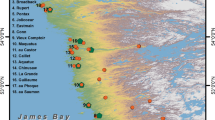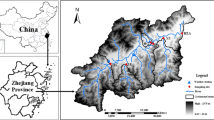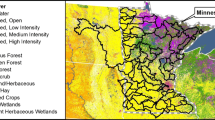Abstract
Spatial variability in material fluxes within large river basins may arise from point source inputs, variable contributions from sub-basins and longitudinal variation in material transformation and retention. By measuring instantaneous fluxes throughout the Ohio River basin, we were able to draw inferences about the importance of these factors in determining the overall export of C, N and P from the basin. Our study spanned the lower 645 km of the Ohio River and included all tributaries that contributed at least 1% of the volume of the Ohio River at its confluence with the Mississippi. The intensively cultivated northern sub-basin (Wabash River) contributed a large fraction of N and P entering the Ohio River. In the southern sub-basins (Tennessee and Cumberland Rivers), impoundments and less intense cultivation appear to diminish and delay material delivery particularly with respect to N. The southern rivers account for a proportionately larger fraction of the water entering the Mississippi River during low discharge conditions and this fraction has increased during the past 50 years. The upper portion of the study reach was found to be a net source of CHLa and DOC and a net sink for inorganic N suggesting that this portion of the river provided a generally favorable environment for autotrophic production. Point source loadings of NH4 were significant inputs to the upper sub-reach but a relatively small component of the overall budget for dissolved inorganic N.








Similar content being viewed by others
References
Alexander RB, Smith RA, Schwarz GE. 2000. Effect of stream channel size on the ‘ delivery of nitrogen to the Gulf of Mexico. Nature 403:758–61
APHA Standard Methods for the Examination of Water and Wastewater. 1998. American Public Health Association, 20th edition. Washington, DC, USA
Arar EJ, Collins GB. 1997. In Vitro Determination of chlorophyll a and pheophytin a in marine and freshwater phytoplankton by fluorescence, Methods for the determination of chemical Substances in marine and estuarine environmental samples. USEPM, p 1–12
Baldwin CK, Lall U. 1999. Seasonality of streamflow: The upper Mississippi River. Water Resou Res 35:1143–54
Bukaveckas PA, Likens GE, Winter TC, Buso DC. 1998. A comparison of methods for deriving solute flux rates using long-term data from streams in the Mirror Lake watershed. Water, Air, and Soil Pollution 105:277–803
Bukayeekas PA, Williams JJ, Hendricks SP. 2002. Factors regulating autotrophy and heterotrophy in the main channel and an embayment of a large river impoundment. Aquat Ecol 36:355–69
Bukaveckas PA, Crain AS. 2002. Interannual, seasonal and spatial variability in nutrient limitation of phytoplankton production in a river impoundment. Hydrobiologia 481:19–31
Caraco NF, Cole JJ, 1999. Human impact on nitrate export: An analyses using major world rivers. Ambio 28:167–70
Capato NF, Cole JJ, Likens GE, Lovett GM, Weathers KG. 2003. Variation in N03 export from flowing waters of vastly different sizes: Does one model fit all? Ecosystems 6:344–32
Clark GM, Broshears RE, Hooper RP, Goolsby DA. 2002. Evaluating the influence of source basins on downstream water quality in the Mississippi River. J. Am. Water Resour Ass 38:803–18
Cole JJ, Caraco NF. 2001. Carbon in catchments; connecting terrestrial carbon losses with aquatic metabolism. Mar Freshwater Res 52:101–10
Devol AH, Hedges JL. 2001. Organic matter and nutrients in the mainstem Amazon River. In: McClain ME, Victoria R, Richey JE, Eds.The Biogeochemistry of the Amazon Basin.Oxford University Press, New York, pp 275–306
Dynesius M, Nilsson C. 1994. Fragmentation and flow regulation of river systems in the northern third of the world. Science 266:753–62
Fry B, Alien YC. 2003. Stable isotopes in zebra mussels as bioindicators of river-watershed linkages. River Res Appl 19:683–96
Gallegos CL, Jordan TE, Correll DL, 1992. Event-scale response of phytoplankton to watershed inputs in a sub-estuary: timing, magnitude and location of blooms. Limnol Oceanogr 37:813–28
Goolsby DA, Battaglin WA, Aulenbach BT, Hooper RP. 2001. Nitrogen input to the Gulf of Mexico. J Environ Qual 30:329–36
Guelda DL, Koch RW, Jack JD, Bukaveckas PA. 2004. Experimental evidence for density-dependent effects and the importance of algal production in determining population growth rates of riverine zooplankton. River Res Appl 2005
Hall RO, Bernhardt ES, Likens GE. 2002. Relating nutrient uptake with transient storage in forested mountain streams. Limnol Oceanogr 47:255–65
Hall RO, Tank JL. 2003. Ecosystem metabolism controls nitrogen uptake in streams in Grand Teton National Park, Wyoming. Limnol Oceanogr 48:1120–28
Hanson PC, Bade DL, Carpenter SR, Kratz TK. 2003. Lake metabolism: Relationships with dissolved organic carbon and phosphorus. Limnol Oceanogr 48:1112–19
Harris GP. 2001. Biogeochemistry of nitrogen and phosphorus in Australian catchments, rivers and estuaries: effects of land use and flow regulation and comparisons with global patterns. Mar Freshwater Res 52:139–49
Howarth RW, Bille G, Swaney D, Townsend A, Jaworski NA, Lajtha K, Downing JA, Elmgren R, Caraco NF, Jordan T, Berendse F, Freney J, Kudeyarov V, Murdoch PS, Zhao-liang Z, 1996. Regional nitrogen budgets and riverine N and P fluxes for the drainages to the North Atlantic Ocean; natural and human influences. Biogeochemistry 35:181–226
Jossette G, Leporcq B, Sanchez N, Philippon X, 1999. Biogeochemical mass-balances (C, N, P, Si) in three large reservoirs of the Seine Basin (France). Biogeochemistry 47:119–46
Koch RW, Guelda DL, Bukaveckas PA. 2004. Phytoplankton growth in the Ohio, Cumberland and Tennessee Rivers, USA: inter-site differences in light and nutrient limitation. Aquat Ecol 38:17–26
Kohler J. 1994. Origin and succession of phytoplankton in a river-lake system (Spree. Germany), Hydrobiologia 289:73–83
Kritzberg ES, Cole JJ, Pace ML, Graneli W, Bade DL. 2004. Autochthonous versus allochthonous carbon sources to bacteria: Results from whole-lake 13C addition experiments. Limnol Oceanogr 49:588–96
Lewis WM, Melack JM, McDowell WH, McClain ME, Richey JE. 1999. Nitrogen yields from undisturbed watersheds in the Americas. Biogeochemistry 46: 149–62
Mekck JM, Forsberg BR, 2001. Biogeochemistry of Amazon floodplain lakes and associated wetlands. In: McClain ME, Victoria R, Richey JE, Eds. The piogeochemistry of the Amazon Basin. Oxford University Press, New York, pp 235–74
Muller-Solger A, Jassby AD, Muller-Navarra DC. 2002. Nutritional quality of food resources for zooplankton (Daphnia) in a tidal freshwater system (Sacramento-San Joaquin River Delta). Limnol Oceanogr 47:1468–76
[NID] National Inventory of Dams. 2000. http://www.crunch.tec.army.mil/nid/webpages/nid.cfm
Paerl HW, Bales JD, Ausley LW, Buzzelli CP, Crowder LB, Eby LA, Fear JM, Go M, Peierls BL. Richardson TL, Ramus JS. 2001. Ecosystem impacts of three sequential hurricanes (Dennis, Floyd, and Irene) on the United States’ largest lagoonal estuary, Pamlico Sound, NC. Proceedings of the National Academy of Sciences USA 98:5655–60
Pearson WD. 1992. Historical changes in water quality and fishes of the Ohio River. In: Becker CD, Neitzel DA. Eds. water quality in North American river System. Battelle Press, Columbus, pp 209–31
Presing M, Herodek S, Preston T, Voros L. 2001. Nitrogen uptake and the importance of internal nutrogen loading in Lake Balaton. Freshwater Biol 46:125–39
Raymond PA, Cole JJ. 2003. Increase in the export of alkalinity from North America’s largest river. Science 301:88–91
Reynolds CS, Descy JP, 1996. The production, biomass and structure of phytoplankton in large rivers. Arch Hydrobiol 113:161–87
Richey-JE, Hedges JI, Devol AH, Quay PD, Victoria R, Martinelli L, Forsberg BR. 1990. Biogeochemistry of carbon in the Amazon River. Limnol Oceanogr 35:352–71
Salvia M, Iffly JF, Vander Borght P, Sary M, Hoffman L. 1999. Application of the ‘snapshot’ methodology to a basin-wide analysis of phosphorus and nitrogen at stable low flow. Hydrobiologia 410:97–102
Scavia D, Rabalais NN, Turner RE, Dubravko J, Wiseman WJ Jr. 2003. Predicting the response of Gulf of Mexico hypoxia to variations in Mississippi River nitrogen load. Limnol Oceanogr 48:951–6
Schaus MH, Vannie MJ, Wissing TE, Bremigan MT, Garvey JE, Stein RA. 1997. Nitrogen and phosphorus excretion by detritivorous gizzard shad in a reservoir ecosystem. Limnol Oceanogr 42:1386–97
Sellers T. 2001. Effects of water regulation on autochthonous production in a large river: A modeling and mass balance approach. PhD. Dissertation Kentucky: University of Louisville, Louisville
Sellers T, Bukaveckas PA. 2003. Phytoplankton production in a large, regulated river: A modeling and mass balance assessment. Limnol Oceanogr 48:1476–87
Servais P, Gosselain V, Joaquim-Justo C, Becquevort S, Thome JP, Descy JP, 2000. Trophic relationships between planktonic microorganisms in the River Meuse (Belgium): a carbon budget. Arch Hydrobiol 149:625–53
Shostell J, Bukaveckas PA. 2004. Seasonal and interannual variation in nutrient fluxes from tributary inputs, consumer recycling and algal growth in a eutrophic river impoundment, Aquat Ecol [in press]
Sjodin AL, Lewis WM, Saunders JF. 1997. Denitrification as a component of the nitrogen budget for a large plains river. Biogeochemistry 39:327–42
Sparks RE, Spink A. 1998. Disturbance, succession, and ecosystem processes in rivers and estuaries: effects of extreme hydrologic events. Regul Rivers 14:155–9
Stanley EH, Doyle MW. 2002. A geomorphic perspective on nutrient retention following dam removal. BioScience 52:693–701
Thorp JH, Delong MD. 2002. Dominance of autochthonous autotrophic carbon in food webs of heterotrophic rivers. Oikos 96:543–350
Turner RE, Qureshi N, Rabalais NN, Dortch Q, Justic D, Shaw RF, Cope J. 1998. Fluctuating silicate:nitrate ratios and coastal plankton food webs. Proceedings of the National Academy of Sciences USA 95:13048–51
Turner RE, Rabalais NN. 2004. Suspended sediment, C, N, P, and Si yields from the Mississippi River basin. Hydrobiologia 511:79–89
USEPA. 2003. Permit compliance system database for national pollutant discharge elimination system permits. http://www.epa.gov/enviro/html/pcs/
USGS. 2000. Data on nutrients in the streams, rivers and groundwater of the United States. National water quality assessment program. http://www.water.usgs.gov/nawqa/
Vanni MJ, Renwick WH, Headworth JL, Auch JD, Schaus MH, 2001. Dissolved and particulate nutrient flux from three adjacent agricultural watersheds: A five-year study. Biogeochemistry 54:85–114
Vorosmarty CJ, Sharma KP, Fekete BM, Copeland AH, Holden J, Marble J, Lough JA. 1997. The storage and aging of continental runoff in large reservoir systems of the world. Ambio 26:210–9
Wollheim WM, Peterson BJ, Deegan LA, Hobbie JE, Hooker B, Bowden WB, Edwardson KJ, Arscott DB, Hershey AE, Finlay J. 2001. Influence of stream size on ammonium and suspended particulate nitrogen processing, Limnol Oceanogr 46:1–13
Acknowledgements
The authors would like to thank Rich Schultz for his assistance with sample analyses. Anthony Aufdenkampe and Peter Groffman provided helpful comments. The Ohio River Valley Sanitation Commission provided unpublished data on effluent chemistry for the Morris Forman wastewater treatment plant.
Author information
Authors and Affiliations
Corresponding author
Rights and permissions
About this article
Cite this article
Bukaveckas, P.A., Guelda, D.L., Jack, J. et al. Effects of Point Source Loadings, Sub-basin Inputs and Longitudinal Variation in Material Retention on C, N and P Delivery from the Ohio River Basin. Ecosystems 8, 825–840 (2005). https://doi.org/10.1007/s10021-005-0044-3
Received:
Accepted:
Published:
Issue Date:
DOI: https://doi.org/10.1007/s10021-005-0044-3




